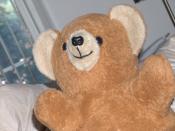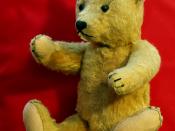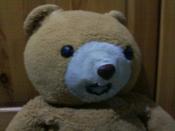According to legend, the teddy bear was first created in 1902 because President Theodore Roosevelt was unable to kill a small bear cub that his tracker brought to him to shoot during a hunting trip. Once the press heard about this, they began advertising cartoons on the Presidents refusal to kill the young cub.
Vermont Teddy Bear was founded in 1981 by John Sortino because he noticed that all of his son's teddy bears were made outside of the United States. He wanted to make one that was made and manufactured here in the states. He did all of the work himself through self-taught lessons, and also began drawing classes to be able to create them himself.
In your text read Case 27, "The Vermont Teddy Bear Co., Inc: Challenges Facing a New CEO" (pages 27-1 through 27-22). Using the case, your readings, the Cybrary and the Internet, develop both an EFAS (External Factors Analysis Summary) Table and an IFAS (Internal Factors Analysis Summary) Table.
It is important that you submit with your tables a description of both your environmental and internal scanning process, including what factors you considered and why.
1a) EFAS Table EFAS Table External Factors Weight Rating Weighted Score Comments 1 2 3 4 5 Opportunities Private Equity Investment Firm 0.2 5 1 more money for working capital Sale-Lease back transaction 0.1 5 0.5 Paid off mortgage and line of credit Purchase of off-shore production inventory 0.1 3 0.3 lower costs for production Trend in holiday sales 0.05 2 0.1 boost of profit for these holidays Tom Shephard to the Board of Directors 0.05 3 0.15 strong financial and operations experience Threats Retail Stores 0.1 3 0.3 annual payments too high Competition 0.05 2 0.1 Disney seems to be biggest competitor Name Recognition 0.1 3 0.3 Bear-Gram seems to be only association New Product Marketing 0.1 2 0.2 keeping within "bear" product line Product Availability 0.15 1 0.15 most people will buy any bear Total Score 1 3.1 1b) EFAS External Scanning Opportunities: I chose factor 1 because it will provide the additional funds will provide working capital for the company to pursue growth in the Bear - Gram channel and to maximize the benefits of importing raw material.
Factor 2 was chosen because these finances were used to pay off the mortgage and the line of credit which was coming up due.
Factor 3 was is important because this will allow the company to produce a better, lower cost product and would provide the flexibility to meet a broader range of price points is response to customer needs. The new label would read "Made in America, of domestic and foreign materials." Factor 4 represents how sales are definitely higher during peak Teddy Bear holidays. These holidays include Valentine's Day, Birthdays, New Births, Get Wells, and Christmas. The opportunity would be to boost advertising while getting close to these holidays so that there would be plenty of products to sell during this time frame.
Last, but not least, Factor 5 was selected because Tom Shephard has strong financial and operations experience, thus bringing a valuable perspective to the Board of Directors. Any time that a new set of eyes looks at a situation, there becomes more room for growth and expansion. New thoughts and ideas could be implemented into the advertising, production, or even financial areas when a person of his abilities is brought on board.
Threats: I chose Factor 1 because the retail store locations that The Vermont Teddy Bear Co, though ideal locations, were very expensive. The rent on the New York store alone was $300,000 annually, which was $100,000 over the annual repayment amount for the loan that the company received from Green Mountain Capital.
Factor 2 was chosen because there are a lot of companies out there that build teddy bears. All you gave to do is type in "teddy bear sales" on Google and 9 different teddy bear companies come up on the first page alone, and there are 10 pages of sites to look at.
Factor 3 is important because not many people know about The Vermont Teddy Bear Co. I didn't. I had never heard of the company until this assignment came up and I'm a teddy bear lover.
Factor 4 represents the fact that there are not a lot of products that can be developed and stay within the teddy bear product line. I think that there will be a lot of constraints on how many new products can be developed within this type of industry.
Finally, Factor 5 is important because most people, like me, don't care where a bear comes from. It will only be the devote customers and collectors that will care where their teddy bear is pushed from.
2a) IFAS Table IFAS Table Internal Factors Weight Rating Weighted Score Comments 1 2 3 4 5 Strengths Employee Relations 0.05 5 0.25 "Bear People" were appreciated Management 0.15 4 0.6 knowledgeable in their fields Shelburne Plant 0.15 5 0.75 great location of tourists to visit Quality product 0.1 5 0.5 not many returns New CEO 0.05 3 0.15 new ideas for expansions Weaknesses Distribution Channels 0.05 2 0.1 Bear-Gram seems to be only good channel Sales 0.2 3 0.6 need to boost sales to return profit Facilities 0.15 3 0.45 too much, too fast Change of Management 0.05 2 0.1 too many CEO's in a short amount of time.
Advertising 0.05 1 0.05 main use of radio stations Total Score 1 3.55 2b) IFAS Internal Scanning Strengths: Factor 1 was chosen because employee relations are very important. It has been proven that when an employee feels respected and appreciated they are apt to be more productive and reliable. The Vermont Teddy Bear Co. has given the employees the name of "Bear People" to express this appreciation. The company does not have union, which shows that management is able to communicate well with their employees.
Factor 2 was selected because it is also important that management is knowledgeable in their field. If management doesn't appear competent, then the employees have a hard time trusting the authority of such managers. In the case of Vermont Teddy Bear Co., each manager appears to have had several years of experience in their fields, thus experience is the best form of knowledge.
Factor 3 is important because the Shelburne, Vermont facility had become facility where customers could take a guided or self-directed tour that showed the entire teddy bear making process. In 1998, approximately 129,000 people toured this facility. This is great for customer relations because people, in general, love to know how a product is made. This will also help to boost sales because a lot of people will purchase a teddy bear on site after taking the tour, especially if they have children with them.
Factor 4 represents how the company values their customers and how much pride they have in their product. Vermont Teddy Bear's policy is "Guarantee for Life." This means that they are willing to repair or replace their teddy bears even if it was eaten by the family dog or destroyed by a lawn mower. Not many companies have this good of a return policy.
Factor 5 was selected because it is important to have a CEO that cares about where the company has been, where it is going, and to have a solid vision of where they want it to be. R. Patrick Burns only lasted as CEO for two years, but his expertise was in marketing. It takes somebody with a solid financial background to fully understand what it takes to be a productive CEO. Elizabeth B. Robert, current CEO, replacing Burns in 1997, has the financial background that can help get the company back into a favorable financial position.
Weaknesses: Factor 1 was chosen because, although the "Bear-Gram" has proven to be the best distribution channel in the past, the company cannot rely solely on this channel. Eventually, consumers will get tired of it and another teddy bear company will come along and do it better. A great example of this is when Disney Enterprises Inc. came up with the "Pooh-Gram". Luckily, Vermont Teddy Bear Co. was able to enter into negotiations with Disney and come to a professional agreement that benefited both companies, but this may not also be true.
Factor 2 is most important because, obviously, if sales continue to decrease then so do profits. Sometimes, as in 1994, sales may be stable, but expenses such as general and administrative expenses, continue to grow. It is vital that sales continue to grow along with the expenses. In order for this to happen, distribution channels need to grow (see Factor 1).
Factor 3 has proven to be a weakness for this company. In 2 years time, 3 retail locations were opened. Two of these locations had a very high annual rent. The management team assumed that since sales were good at their Shelburne facility that the same would be true for other retail facilities. I think they attempted too much, too fast. In my opinion, retail stores were a good avenue to pursue, but moving too quickly, without adequate research, it proved to be detrimental to the bottom line.
Factor 4 was selected because when a company has too many high-management changes, it gives, not only the consumers, but especially the employees the sense that the company doesn't know what it's doing and a fear that they company won't last. Once this fear becomes apparent employees will begin looking for other employment opportunities, trying to be proactive in their own lives.
Factor 5 is a result of failures in other avenues that were attempted. Although radio advertising has proven to do well for the "Bear-Gram", if other distribution channels are to be adopted, so does other advertising channels. Radio advertising wouldn't do as well at promoting the tours that are available at the Shelburne facility. I feel that a television advertisement would be better for this type of channel because it's a more visual avenue.
In conclusion, I have found that The Vermont Teddy Bear Co. has made some very poor decisions when it comes to marketing and advertising. They seem to value their products, employees, and consumers. Because of this I think that they will continue to work hard at getting the company out of the red and back into a profitable position.
It is my recommendation that Elizabeth Robert continues as CEO and that she relies on the organization management that John Sortino wanted for the company. I think that they should not rely so heavily on the "Bear-Gram", because as stated above, this distribution channel will not always be open. I feel that they need to rely more on the Shelburne, Vermont facility tour, and begin an aggressive advertising campaign to help boost the retail sales area.
Resources: Wheelan, Thomas L. & Hunger, J. David, (2006). Strategic Management and Business Policy (10th ed.). Upper Saddle River, NJ: Pearson Education.
Google search of teddy bear sales, retrieved September 15, 2006 from: http://www.google.com/search?hl=en&q=teddy+bear+sales Wikipedia, the Free Encyclopedia, Teddy Bear, retrieved September 15, 2006 from: http://en.wikipedia.org/wiki/Teddy_bear Barnett, Amy (2006, September 15, 2006). Student, American InterContinental University, Personal interview.


